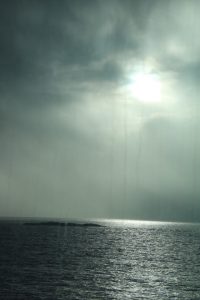We departed Ålesund at 09:30 with light snow showers and a temperature of 2ºC. We are heading north but because of the storm we will not be stopping at Brønnøysund. The storm is massive and we have seen it on BBC World Weather.
By lunchtime, when we were in the open ocean there were high waves and a big sway which led to the removal of unused glassware and crockery from the tables in the restaurant. This is a reminder to us of the exposure of this coastline to winds from the Americas. Prior to this we had over-sailed several sub-sea road tunnels connecting the mainland to islands, such as the Valderøytunnelen, opened in 1987 with a length of 422m and at a depth of 137m.
Around 14:30 the Captain announced that we were, “done with it” and were moving into the Inner Passage.
Much of today’s voyage is past the western fjord region. This is an area of granite mountains scoured and gouged by glaciers and ice sheets over many millions of years. Some hills remain that were eroded by the ice and today look like resting sheep, with a smooth back and ragged front. These were shaped by the ice as it moved over them and are known as roche-moutonnée. These are much larger than any we have seen in the Thousand Islands section of the St. Lawrence River (Canada) or in northern Scotland.
Moving northwards we passed numerous remote and low islands, some of which house very large wind farms. One such group of islands, the Vega archipelago, is a Unesco World Heritage site and has been awarded this because of the human endeavour through many generations of maintaining a sustainable way of life (fishing and farming) in an inhospitable landscape.
That’s all for today from your hardworking Bloggers!








